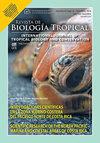Ex situ culture of coral species Porites lobata (Scleractinia: Poritidae) and Pocillopora damicornis (Scleractinia: Pocilloporidae), Costa Rica: first assessment and implications
IF 0.6
4区 生物学
Q4 BIOLOGY
引用次数: 0
Abstract
Introduction: Coral reefs worldwide-decline has prompted coral restoration as a viable strategy to rewild vulnerable, foundational coral species. Stony corals are now propagated by the thousands in both in-water and ex situ (land-based) coral nurseries, the latter being unexplored in Costa Rica, despite their potential benefits as a reef management tool. Objective: To analyze the viability of ex situ culturing of the Pacific reef-building corals Porites lobata and Pocillopora damicornis at Parque Marino del Pacífico (PMP), Puntarenas, Costa Rica, aquaculture facilities. Methods: From May to October 2018 a total of 180 coral fragments were kept in an aquaculture recirculated system. Survival, growth, and fragment yield in relation to culture medium (physicochemical parameters) were recorded. Results: Survival and growth rate varied between species and culture tanks. On average, surviving P. lobata fragments (68.89 %) placed in Tank 1 (T1) grew 216 %, while fragments placed in Tank 2 (T2) had a survival rate of 71.11 % and an increase of 277 % in live tissue area. P. damicornis fragments survival, basal and crown area percentage increase were: 71.11 %, 980 % and 366 % in T1, and 100 %, 976 % and 287 % in T2. Although fragments survival and growth were net positive, the yield in terms of culture was low, due to culture conditions in the tanks not meeting coral culture optimal requirements. Conclusions: Survival and growth of both species varied depending on the tank in which they were placed. Survival was similar to that found in other ex situ studies and growth was similar to those reported in the wild, however culture performance in terms of yield was low. Aquaculture systems at PMP constitute a good base for the cultivation of corals, however for the culture effort to achieve maximum yield, current systems must be optimized according to the requirements of the target coral species.哥斯达黎加洛巴塔Porites lobata(硬核菌门:Poritidae)和达米科尼Pocillopora damicornis(硬核虫门:Pocilloboridae)珊瑚物种的迁地培养:首次评估和意义
引言:全球珊瑚礁数量的减少促使珊瑚恢复成为重建脆弱基础珊瑚物种的可行策略。石珊瑚现在在水中和非原位(陆地)珊瑚苗圃中繁殖,后者在哥斯达黎加尚未开发,尽管它们作为珊瑚礁管理工具具有潜在的好处。目的:分析在哥斯达黎加Puntarenas Marino del Pacífico公园(PMP)水产养殖设施中原位培养太平洋造礁珊瑚Porites lobata和Pocillopora damicornis的可行性。方法:2018年5月至10月,共有180块珊瑚碎片被保存在水产养殖循环系统中。记录与培养基(物理化学参数)相关的存活、生长和片段产量。结果:不同物种和不同培养罐的存活率和生长速率不同。平均而言,放置在储罐1(T1)中的存活大叶藻碎片(68.89%)生长了216%,而放置在储罐2(T2)中的碎片的存活率为71.11%,活组织面积增加了277%。达米康尼的碎片存活率、基底和冠面积百分比在T1分别为71.11%、980%和366%,在T2分别为100%、976%和287%。尽管碎片的存活和生长是净阳性的,但由于培养箱中的培养条件不符合珊瑚培养的最佳要求,培养产量较低。结论:这两个物种的生存和生长取决于它们所处的水箱。存活率与其他迁地研究中发现的相似,生长与野外报告的相似,但产量方面的培养表现较低。PMP的水产养殖系统是珊瑚养殖的良好基础,但为了实现最大产量,必须根据目标珊瑚物种的要求对现有系统进行优化。
本文章由计算机程序翻译,如有差异,请以英文原文为准。
求助全文
约1分钟内获得全文
求助全文
来源期刊

Revista De Biologia Tropical
生物-生物学
CiteScore
1.80
自引率
0.00%
发文量
23
审稿时长
4-8 weeks
期刊介绍:
The Revista de Biología Tropical / International Journal of Tropical Biology and Conservation is a mainstream scientific journal published since 1953 and covered by Web of Science; Science Citation Index; Current Contents; Google Scholar; Scopus, SciELO and nearly 50 additional indices.
A double blind system guarantees you a fair evaluation, and our world class editorial and scientific boards provides a first decision in three working days. The journal is Full Open Access and is widely read where your article can have the highest real impact.
Since its beginning in 1953, the Revista follows these principles: objective and independent evaluation of all manuscripts; transparency in all processes; ethical use of procedures, data, specimens and subjects; fair treatment of all parties; and absolute predominance of scientific rigor over any other aspect.
 求助内容:
求助内容: 应助结果提醒方式:
应助结果提醒方式:


